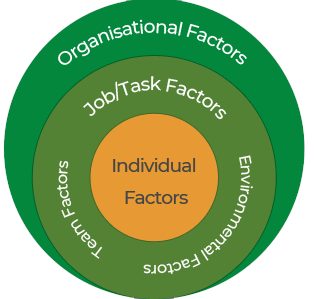Different kinds of errors and violations can happen when people do tasks. Humans are prone to errors, but some things can make them more likely and other things can create a situation where it seems like the best option is to break a rule. The focus of human factors is understanding what these ‘things’ are and how they can be improved. These ‘things’ have lots of different names (e.g. Performance Shaping Factors, Error Producing Conditions) but here we will call them Performance Influencing Factors (PIFs). Performance Influencing Factors cover a very wide range of different things that can influence how well somebody can do a task. Even in everyday life, it’s pretty easy to make a cup of tea but it’s much harder to do it while on the phone, after a bad night’s sleep, with the lights off, with a cup with a broken handle, and if you are short and the kettle is on a high shelf. All these influence how difficult it is to make that cup of tea – as performance influencing factors they would be termed distraction, fatigue, lighting, and poor equipment and workplace design. We might be able to cope with one of two of these at a time; but if all five are present, the chances of getting a good cup of tea without any split milk or burned fingers is pretty low. The same is true in work situations; it’s not possible for work conditions to be perfect all of the time – distractions do happen, equipment can break, personal lives do get complicated and cause stress – but the more performance influencing factors that are present, the more likely errors become. You might have come across this idea before as the ‘Swiss Cheese’ model – the performance influencing factors are holes in the slices of Swiss cheese. The more holes in slices, the more likely an error or incident.
 The onion model summarises the different categories of performance shaping factors. The individual doing their work, whether they are a train driver, a dispatcher, a signaller or any other role, is at the centre of the model. They themselves can be a factor – for example, they can be tired, or have personal issues they are dealing with that distract them, or not have enough experience of the task they are doing. But they are just one element of the railway system and people don’t work in isolation, they are influenced by what is going on around them. To promote safe performance following an incident, human factors tries to think about not only what the individual involved did but also why they did it – what influenced their error or decision to break a rule? What information did they have in that moment in time and what were they trying to achieve? Human factors specialists also think in this way when working on the design of new systems or equipment, or making changes to them. How will that new equipment be used? What influence will a new procedure have on people’s ability to work safely and efficiently? Most human factors work is around the other layers of the onion: the task, environment, team and organisation because it is usually more effective to design the task for the human rather than trying to fit the human to the task.
The onion model summarises the different categories of performance shaping factors. The individual doing their work, whether they are a train driver, a dispatcher, a signaller or any other role, is at the centre of the model. They themselves can be a factor – for example, they can be tired, or have personal issues they are dealing with that distract them, or not have enough experience of the task they are doing. But they are just one element of the railway system and people don’t work in isolation, they are influenced by what is going on around them. To promote safe performance following an incident, human factors tries to think about not only what the individual involved did but also why they did it – what influenced their error or decision to break a rule? What information did they have in that moment in time and what were they trying to achieve? Human factors specialists also think in this way when working on the design of new systems or equipment, or making changes to them. How will that new equipment be used? What influence will a new procedure have on people’s ability to work safely and efficiently? Most human factors work is around the other layers of the onion: the task, environment, team and organisation because it is usually more effective to design the task for the human rather than trying to fit the human to the task.
